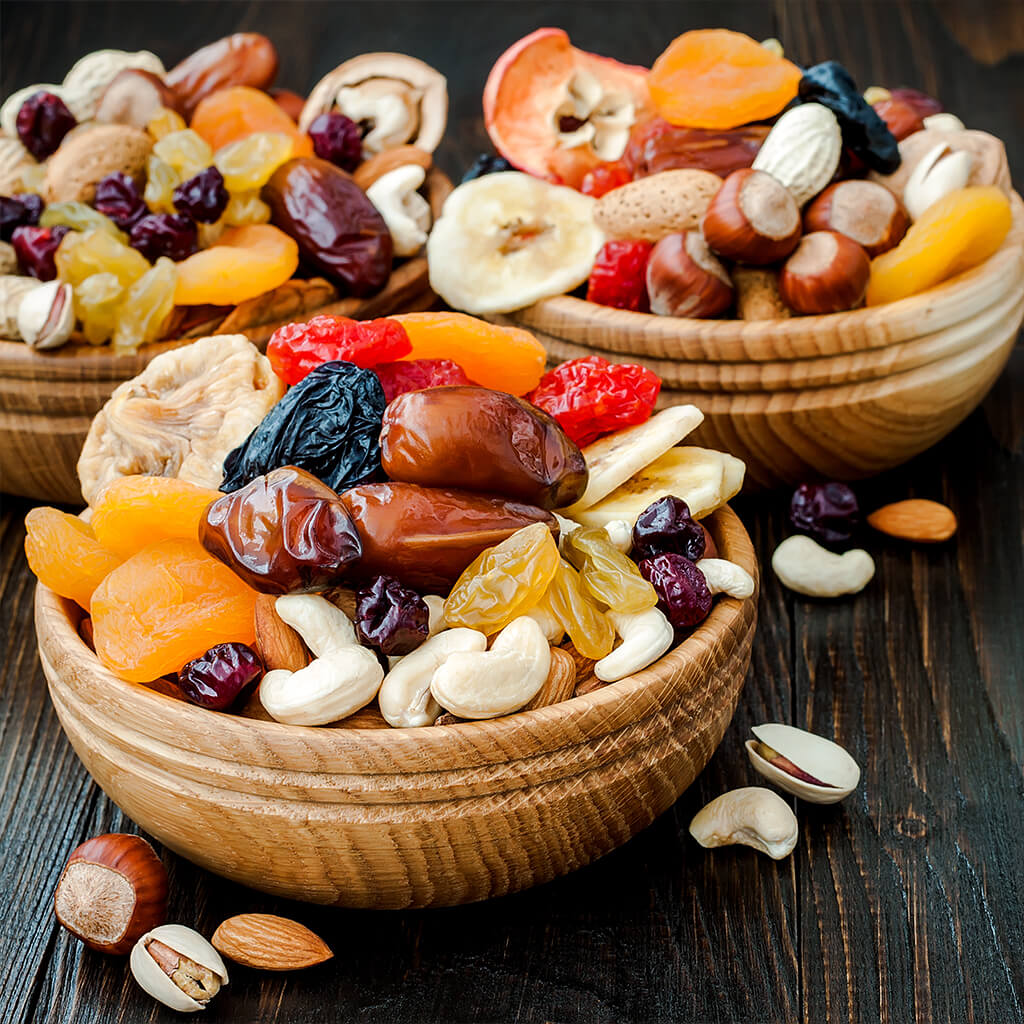Dried fruits and nuts: everything you need to know

Publication date: 29-01-2021
Updated on: 16-05-2025
Topic: Nutrition
Estimated reading time: 1 min
Article Author
Elena BuonannoMedical Editor
Federica Grandi
Editor and Translator
Viktoryia LuhakovaAlmonds, walnuts, pistachios, dates, figs, apricots: nuts and dried fruits are the protagonists of the winter season. Here is what you need to know about their calories, nutritional properties and how to consume them
One of the protagonists of the winter season is undoubtedly dried fruit, often accompanied by nuts. Do you know its nutritional properties? Let's find it out together with dieticians of the Center for Eating Disorders at the Policlinico San Pietro Dr. Claudia Delpiano and Dr. Federica Grandi.
Nuts: caloric and nutritional value
There are many types of nuts: walnuts, hazelnuts, pistachios, cashews, pine nuts, Brazil nuts, pecans and many more. Although their shape and taste are different, all types are characterized by a high calorie content that on average is around 600 kcal per 100 grams.
"When we talk about nuts we refer to a food category characterized by a high energy density, fiber, folic acid, antioxidant molecules such as tocopherols and phytosterols (substances capable of counteracting free radicals, which are the main responsible for cellular aging) and an important content of quality fatty acids, such as omega-3. They are called "good fats" because they help to keep the cardiovascular system healthy,” explain dieticians of the Policlinico San Pietro.
Daily portion
But in what quantities nuts should be included in the diet that we can take advantage of its benefits without effects on our shape?
“The Guidelines for a Healthy and Correct Nutrition recommend small portions of 20-30 grams, 2-3 times a week. Nuts can become an excellent snack to eat between main meals, especially in those situations when it is difficult to have a proper lunch. Also, it can be an excellent alternative to classic snacks even for sportsmen and children.
Ideally, you can divide nuts into portions to take with you (20-30 grams) which, for example, correspond to about 10 almonds or 4 walnuts. Often the high palatability and ease of consumption lead us to consume larger quantities. It is therefore better to avoid carrying large quantities with us,” observes Dr. Grandi.
“Another important tip is to choose nuts with no salt or sugar. Alternatively, you can also choose it in the form of a spreadable cream, but make sure that the nut itself is the only ingredient on the label,” adds Dr. Delpiano.
“It is also useful to remember that, although nuts contain beneficial substances, it is wrong to consider them 'miraculous' or attribute to them pharmacological properties that they do not possess. Inclusion in already incorrect and unbalanced diet would only increase caloric quantity and add lipid shares. Often, erroneously, high quantities of nuts are combined in salads, in the preparation of dishes or at the end of a meal”.
Recipe: snack with dried fruit and chocolate
A healthy idea to increase the consumption of dried fruit can be to add it to natural yogurt (Greek or classic), perhaps also enriching it with fresh seasonal fruit. But that's not all: combined with chocolate, it can become a delicious snack for the most active children or for sporty adults. Here is the recipe to prepare it:
- choose the dried fruit mix you prefer, making sure it does not contain any sugar or salt;
- melt a bar of dark chocolate (100 grams) with a percentage of cocoa higher than 75% in a bain-marie;
- when the chocolate is completely melted and without lumps, add the dried fruit, whole or chopped;
- stir so that all the fruit will be completely covered with chocolate;
- with the help of 2 teaspoons, place small amounts of the mixture in small paper cups;
- leave to cool completely and store in airtight glass jars.
Dried fruit: nutritional properties and calories
Alongside nuts, dried fruit is also quite common: apricots, dates, figs, exotic fruit, plums, apples and citrus fruits.
“Dried fruit is the result of a drying process – dehydration, which is obtained by heat and consequent elimination of water. From a nutritional point of view, after drying process, the fruit has some differences compared to the fresh product. Thus, the water-soluble vitamins, in particular vitamin C, tend to degrade, while some substances such as fibers and minerals, especially potassium, magnesium and phosphorus, tend to concentrate.
Fruit subjected to this process undergoes a net weight loss. This implies a higher concentration of sugars for the same weight compared to fresh fruit. From an energy point of view, 100 grams of dried fruit contain on average 300 kcal,” explain the experts.
Daily portion
How to choose the best product?
“Choose dried fruit with no sugar, not glazed or caramelized. Pay attention to additives, especially if the product will also be consumed by children, choosing untreated products, without sulphites or surface preservatives.”
Even dried fruit can be a well-balanced snack, if included in an adequate and correct diet:
“It is a snack with a high energy density and a high sugar content (of which 50% is fructose). This is why it is important to take it in small quantities. Recommended portion is 30-40 grams, 2-3 times a week. It can be an excellent snack for sportsmen or it can be added to sweeten snacks for children, instead of sugar.”
Candied fruits
“The candying process leads to a gradual decrease of water content in favor of the sugar content, which, at the end of the process, is present in an amount greater than 70%. The nutritional properties, on the other hand, are almost completely lost. This is why it is good to limit their consumption. We can compare candied fruit to an occasional sweet,” warn the dieticians.